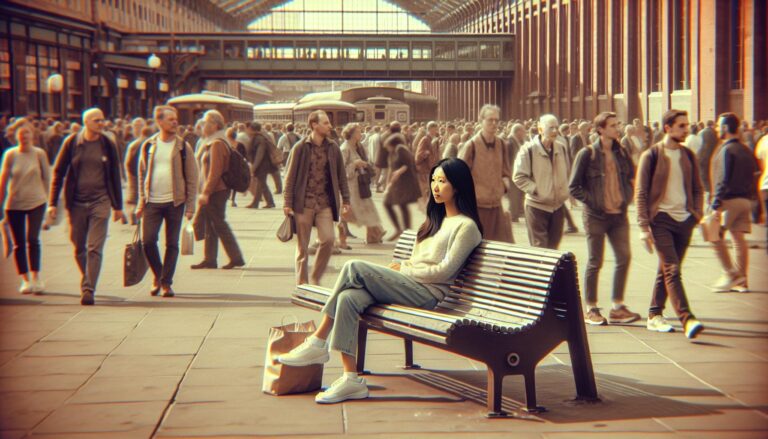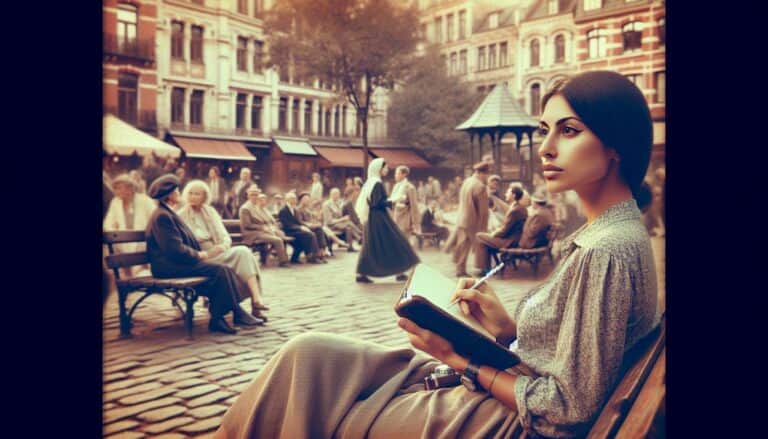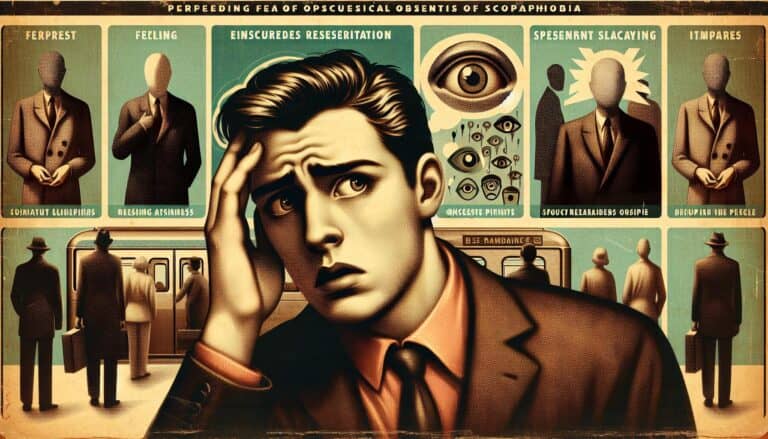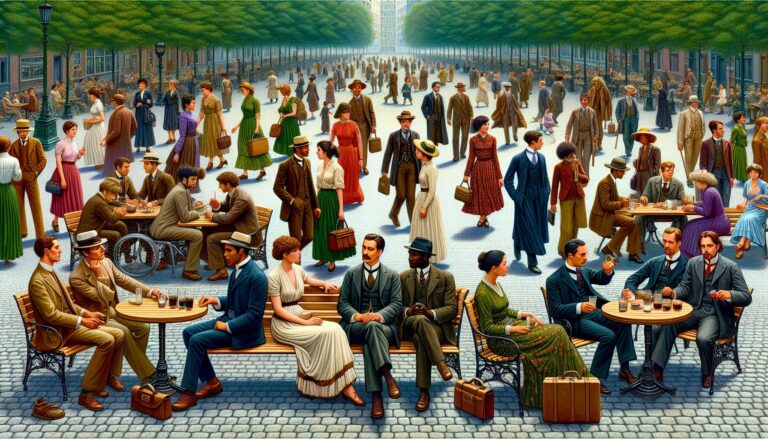Ever found yourself on a train, eyes wandering, and suddenly you’re lost in the stories of strangers around you? People watching on trains isn’t just a way to kill time; it’s an art form, a window into the lives and emotions of those sharing your journey.
From the anxious first-timer clutching their ticket to the seasoned commuter lost in a book, each person has a story. And as the landscapes whiz by, you’re given a unique opportunity to imagine, to understand, or even to learn from the silent tales unfolding before you. Let’s dive into the captivating world of people watching on trains, where every journey brings a new story to life.
Train journeys transform into journeys of discovery through people watching. Observe body language, stories in silent moments, and the diversity of lives. It’s empathy, self-discovery, and inspiration on wheels.
Discovering the Art of People Watching on Trains
When you embark on a train journey, you’re not just traveling from one place to another, you’re stepping into a mobile canvas of human experience. People watching on trains is an art that combines observation, empathy, and imagination. It’s about seeing beyond the surface, understanding that every passenger has a unique story woven into the fabric of their lives.
Observation is your first tool. Pay attention to the details: the way someone grips their book a little too tightly, the subtle signs of a long day on someone’s face, or the excitement in children’s eyes as landscapes whizz by. These moments are fleeting, but they’re intensely revealing if you’re attentive.
Empathy plays a crucial role in people watching. It’s about connecting with the emotions and experiences you observe. Imagine the stories behind the expressions, the sighs, and the laughter. This empathy allows you to delve deeper into the human condition, providing insights into not just the lives of others, but also your own.
To enhance your experience, bring a notebook. Jotting down what you see can help you remember these moments and reflect on them later. It’s also a great way to practice your descriptive writing skills.
Remember, while people watching can be incredibly rewarding, it’s essential to do so with respect and discretion. It’s about observing life in its many forms, not intruding into it.
In a world where we’re often lost in our thoughts and devices, people watching on trains offers a rare opportunity to reconnect with the world around us. Each journey is an unscripted story, and as you learn to watch and interpret these stories, you’ll find yourself more in tune with the nuanced tapestry of human emotions and experiences.
Observing the Diversity of Passengers
When you’re people watching on trains, the diversity of passengers around you is phenomenal. Trains, serving as melting pots, bring together individuals from all walks of life. You’ll find students buried in their books, professionals typing away on their laptops, families sharing stories, and tourists eagerly looking out the window. Each person carries their own unique story, making your observation both enriching and captivating.
- Students: Often surrounded by textbooks, notes, or staring intently at their laptops, their focus is palpable.
- Professionals: Dressed in business attire, they’re usually engrossed in work, sending emails, or making important calls.
- Families: Sharing snacks, playing games, or discussing their plans and adventures.
- Tourists: With cameras at the ready, they’re absorbed in the scenery, often consulting maps or guidebooks.
This diversity isn’t just about their current activities but extends to their emotions and interactions. You might notice a young couple sharing a quiet moment, an elderly person lost in thought, or a group of friends laughing. Observing these details offers you a glimpse into the vast array of human emotions and relationships that unfold in the confined space of a train car.
Paying attention to the different languages spoken or the variety of clothing styles can also reveal the multicultural aspect of train travel. This aspect alone can be incredibly illuminating, showcasing how trains are not just modes of transport but spaces where cultures intersect and interact.
As you immerse yourself in this diverse tapestry of humanity, remember to keep your observations respectful and non-intrusive. The key is to observe quietly and let your imagination and empathy fill in the stories around these snippets of life. This practice not only enriches your people watching experience but also broadens your understanding of the human condition.
Deciphering Body Language and Facial Expressions
When you’re aboard a train, lost in the art of people watching, paying close attention to body language and facial expressions becomes an invaluable skill. These nonverbal cues can tell you a compelling story about your fellow passengers, often revealing more than words ever could. Mastering this skill not only enhances your observation abilities but also deepens your understanding of human emotions and interactions.
Body language varies significantly across different cultures, yet some universal signals convey emotions like happiness, stress, or discomfort. For instance, someone sitting with crossed arms and legs might be signaling that they’re closed off or uncomfortable. In contrast, a passenger who’s relaxed, with open body posture, likely feels secure and content. Observing these subtle changes in body posture can give you profound insights into a person’s current state of mind without them uttering a single word.
Facial expressions are equally telling. The human face can make over 10,000 expressions, but it’s the micro-expressions – brief, involuntary facial expressions that reveal true emotions – that are the most revealing. These quick, often subconscious expressions can be a window into a passenger’s genuine feelings. A slight upturn of the mouth could indicate amusement, whereas a furrowed brow might suggest worry or concentration.
To get better at interpreting these nonverbal cues, practice focusing on one individual at a time, noting their body posture, facial expressions, and any changes that occur. It’s fascinating to piece together what someone might be experiencing just by observing these silent signals. Remember, the key is to be discreet and respectful, maintaining the privacy and comfort of those you observe.
By dedicating yourself to understanding body language and facial expressions, you’ll find that your ability to empathize and connect with the stories unfolding around you on the train enriches your people-watching experience.
Uncovering the Stories behind Strangers
When you delve into people watching on trains, you’re not just observing random individuals; you’re uncovering the untold stories that each person carries with them. This practice transforms a mundane train ride into a fascinating journey through the lives of strangers. Each passenger boarding the train brings a unique narrative, shaped by their emotions, experiences, and destinations.
Observing subtle interactions and solitary moments can provide glimpses into these personal tales. You might notice a young woman anxiously checking her phone, possibly waiting for a life-changing call, or an elderly man smiling at a picture he’s holding, reminiscing about past memories. It’s the small, often overlooked actions that tell the most compelling stories. By paying attention to these details, you start to piece together the rich tapestry of human life unfolding around you.
To enrich your experience:
- Look for patterns in behavior that suggest a broader context.
- Pay attention to the books, electronic devices, and other objects that people interact with as they can offer clues about their interests or state of mind.
- Notice the dynamics between traveling companions, which can reveal insights into their relationships.
By adopting this mindful approach to people watching, you become a silent witness to the diverse stories that play out every day on trains. This not only enhances your observational skills but also fosters a deeper sense of empathy and connection to the world around you. As you quietly observe, remember to maintain respect for the privacy and feelings of those you watch. Your aim is to understand and appreciate the myriad human experiences, not to intrude or judge.
Through the lens of empathy and curiosity, you’ll find that everyone has a story worth knowing, even if it’s just a fragment caught in transit. This ongoing journey of discovery never ends, as every train ride presents new characters and narratives to explore, making each trip an opportunity to learn more about the human condition and your own place within it.
Reflections and Lessons Learned
When you dive into the art of people watching on trains, it’s not just about observing others—it’s a journey into self-discovery and understanding too. As you take note of the subtle interactions and the silent stories unfolding before your eyes, you begin to reflect on your own experiences and perceptions. This practice encourages you to question and empathize, making you more aware of the world’s complex tapestry of emotions and relationships.
One of the key lessons learned from people watching is the realization of our shared humanity. Despite the apparent differences in appearance, language, or behavior, the core emotions—joy, sadness, frustration, and love—are universal. Seeing the weary smiles of parents trying to soothe their children or the silent chuckles of friends sharing an inside joke, you’re reminded of the common thread that binds us all. This fosters a sense of connectedness and empathy, attributes that are increasingly precious in today’s fast-paced world.
Engaging in this silent observation also hones your attention to detail. The smallest actions—a nervous fidget, an affectionate glance, a sigh of relief—can tell you a lot about a person’s state of mind and situation. Over time, you develop a keener eye, not just for people watching but in all aspects of life, enhancing your observation and analytical skills.
Beyond personal growth, these observations often inspire creativity and curiosity. Perhaps you’re a writer looking for stories, an artist capturing moments, or simply someone seeking a deeper understanding of the human condition. The narratives you construct from your observations serve as a wellspring of inspiration, opening your mind to new ideas and possibilities.
As you reflect on the lessons gleaned from watching the world go by from your train seat, remember that each journey offers a fresh perspective. With every trip, you’re not just moving physically; you’re advancing on a path of empathy, curiosity, and connection—qualities that are invaluable as you navigate the larger journey of life.
Conclusion
People watching on trains isn’t just a pastime—it’s an enriching experience that opens your eyes to the myriad stories unfolding around you every day.
By tuning into the details, you’re not only enhancing your observational skills but also fostering a deeper empathy for the people you share your journey with. Remember, every person has a story, and the train is a moving tapestry of human emotions and experiences.
So next time you’re on a train, open your notebook, look around, and let the stories inspire you. It’s more than just a way to pass the time; it’s a chance to connect with the human spirit, learn about the diversity of life, and maybe even discover something new about yourself.
Each journey is an opportunity to see the world through a different lens, and who knows? You might just find that people watching on trains enriches your life in unexpected ways.







